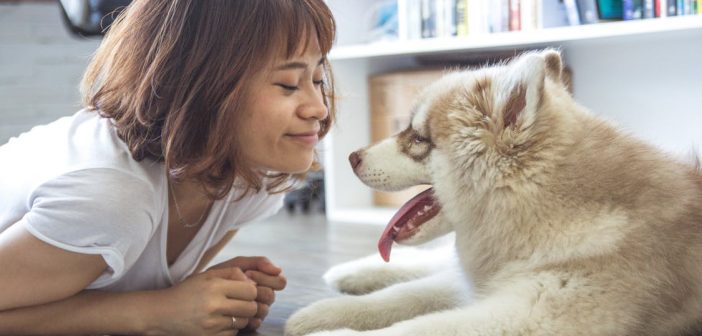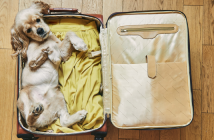Owning a pet means living with pet hair, but dealing with your animal’s fluffy fur doesn’t have to be a chore. Adding a few of these quick actions to your daily routine can help you get on top of the proper care of your pet’s shedding and combat dust and dander.

Grooming
Start at the source and get into a grooming routine with your pet to help reduce the amount of hair that hits the floor in the first place.
Brushing
Not every pet likes to be brushed, but some love it and will consider being groomed quality time. If your dog or cat reacts badly to one kind of brush, try a different style, and incorporate brushing into a soothing routine. Pick a comfortable spot in your house and lay a towel or old blanket down to catch the hair that brushes loose. If you are able to, head outside so the hair that comes loose during brushing doesn’t settle in your house. Some vacuum attachments claim they can be used to directly suction away the hair from your pet’s coat, but stick to more traditional methods: animals find the noise and sensation of the vacuum stressful and it isn’t much more effective than a traditional brush.
Baths
Brushing takes care of the extra hair before it gets shed onto your floor, but if you’re allergic to cats or dogs, you probably also want to reduce the pet dander in your home. To battle dander, you’ll need to give your pet a bath from time to time. Obviously, dogs are easier to bathe than cats, but these tips apply to any household pets you can wrangle into the tub. Bathing work best if you’ve already removed the loose fur from the undercoat with a brush. Repeat the washing and brushing steps several times in the same bath to reach the dander on the skin. A few times a year, splurge on a professional groomer. An appointment during spring or fall can help you get ahead of seasonal shedding.
Fur free floors
Once you’ve reduced the amount of fur your pet sheds in your house, your floors will be noticeably cleaner. Take some of the effort out of cleaning up the remaining hair on your floors by choosing the right tool for each surface.
Dust mops
Hard floors like tile and wood allow loose pet hair to fly around with the least bit of wind. The movement of a broom, or the exhaust of a vacuum tends to blow fur back into the air instead of trapping it for removal. For these floors, grab a microfiber cloth, either the cheaper disposable wipes or a more expensive reusable fabric style. These cloths use electrostatic charges to catch tiny hairs, dust, and dander. Toss them in the trash or the wash and your floors will be cleaner in minutes.
Vacuum
You probably already spend time vacuuming pet hair off your carpets, but prepping your carpets first can make that work more effective. The shape of pet hair allows it to easily get trapped in the fibers of the rug, keeping the vacuum from grabbing them. You can loosen things up by dusting your rug with baking soda or scraping the carpet with a squeegee first. A few times a year, wear a rubber glove or wrap your hand in a damp dishtowel, then wipe the edges of the carpet along the baseboards where the vacuum can’t quite reach. You’ll remove more hair than your regular vacuum routine alone.
Laundry
Just like your carpet, pet hair gets embedded in the fibers of your clothes and can be difficult to remove. The washing machine motion can actually make hair more tangled into your shirts and slacks, so it’s important to loosen it up before it hits the wash cycle. It sounds counter-intuitive, but throw your clothes into the dryer on the cool air tumble cycle for a few minutes to bounce most of the fur off your clothes and into the lint trap.
If you still have furry clothes after this, throw a ½ cup of white vinegar into the wash with your load. It relaxes the fibers and lets the water shake the remaining hair free. When you move clothes to the dryer, use anti-static dryer sheets and wool dryer balls in a regular tumbling cycle. This reduces the static charge on your clean clothes and help them pick up less hair the next time you wear them.
Everything else
So now your pet has less hair, and your floors and clothes are fur-free. Without all that extra hair floating around, you can finally tackle other surfaces in your home.
Smooth surfaces
Like smooth floors, you don’t need many supplies to grab fur from flat surfaces indoors. Wood and glass don’t require special sprays, just grab another microfiber cloth and wet it slightly with plain water. Now you can quickly wipe down your tables, bookcases, and the dusty corners where fur balls collect without redepositing the hair in other places.
Couches and chairs
Of course, your pets love to sit on your furniture, and they leave plenty of hair behind. There’s nothing worse than sitting down in your clean clothes only to realize the chair full of cat hair has transferred to your outfit. Upholstered furniture can be vacuumed, but that’s unwieldy. Instead, rub a damp, clean sponge over your furniture to loosen the hairs and follow up with a microfiber cloth to trap and remove them. You can also proactively cover your furniture with pet safe blankets or bedding. Swap out these portable, washable linens and your couch and armchairs will stay fur-free underneath. Now clean-up is only a load of laundry away.
Clean air
Having less hair and dander in your home should help your air quality, but the final steps to having a clean home with pets is keeping hair and dander out of your air ducts. When loose fur settles into your HVAC system, it recirculates, dropping back onto your freshly cleaned floors and furniture, and irritating your breathing. Schedule a time to get your air ducts cleaned twice a year and change out your air filter whenever it looks dirty to catch and dispose of hair before it blows back into the air you breathe.
A home with pets will never be completely hair free, but by following these cleaning tips you can drastically reduce the amount of dust, dander, and fur you encounter in your living area.







